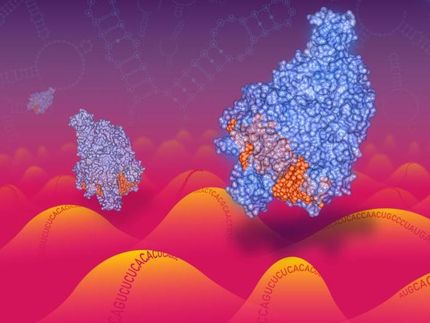A new addition to the CRISPR toolbox: Teaching the gene scissors to detect RNA
Researchers present the PUMA technology for the precise detection of RNA with DNA-cutting Cas12 nucleases
CRISPR-Cas systems, defense systems in bacteria, have become a plentiful source of technologies for molecular diagnostics. Researchers at the Helmholtz Institute for RNA-based Infection Research (HIRI) in Würzburg have expanded this extensive toolbox. Their novel method, called PUMA, enables the detection of RNA with Cas12 nucleases, which naturally target DNA. PUMA promises a wide range of applications and high accuracy. The team published its results in the journal Nature Communications.
Bacteria have developed special defense mechanisms to protect themselves against viruses, which by no means infect only humans. As part of these so-called CRISPR-Cas systems, a CRISPR ribonucleic acid (crRNA), which serves as a “guide RNA,” recognizes regions of a foreign genome, such as viral DNA. The CRISPR-associated (Cas) nuclease, directed by a crRNA, then renders it harmless by cutting it like a pair of scissors. Humans have exploited this strategy: “CRISPR, often referred to as ‘gene scissors’, is the basis of many molecular technologies,” says Chase Beisel, head of the RNA Synthetic Biology department at the Helmholtz Institute for RNA-based Infection Research (HIRI) in Würzburg. The institute is a site of the Braunschweig Helmholtz Centre for Infection Research (HZI) in cooperation with the Julius-Maximilians-Universität (JMU) of Würzburg, where Beisel holds a professorship.
The diagnostic platform LEOPARD, developed by Beisel’s lab in cooperation with JMU in 2021, also leverages CRISPR as a technology. LEOPARD has the potential to detect a variety of disease-related biomarkers in just one test. The approach is based on reprogramming RNA factors, so-called tracrRNAs. Those RNAs are naturally involved in helping produce guide RNAs used by Cas9 and different Cas12 nucleases. “LEOPARD focused on Cas9. However, CRISPR-Cas systems also include another diverse set of nucleases, called Cas12,” explains Beisel. While both Cas9 and Cas12 cut DNA targets, Cas12 can increase the output signal by performing cuts on “collateral” DNA. This can make detection technologies more sensitive and, therefore, more efficient.
The team led by Chase Beisel has now extended the unique features of LEOPARD to Cas12. The researchers have named the resulting method PUMA (Programmable tracrRNAs Unlock protospacer-adjacent Motif-independent detection of ribonucleic Acids by Cas12 nucleases). The details of their findings are the subject of a paper in the journal Nature Communications.
Overcoming hurdles
Although Cas12 nucleases are widely used in molecular diagnostics, two major limitations have persisted: Cas12-based technologies have been restricted to DNA targets, and a specific recognition sequence called a PAM, short for protospacer-adjacent motif, is required to identify the target molecule.
PUMA elegantly addresses these challenges. Like LEOPARD, this new method also relies on tracrRNAs. “Using PUMA, we can reprogram the tracrRNAs. This allows us to decide which RNA biomarker becomes a guide RNA. This guide RNA, in turn, directs Cas12 to a DNA molecule that we provide and activates the gene scissors,” explains the study's first author, Chunlei Jiao. Chunlei Jiao, a former graduate student and postdoctoral researcher in the Beisel lab, was also involved in the development of LEOPARD. He recently started a professorship at the National University of Singapore. “DNA cutting then tells us which biomarker was present in the sample, such as biomarkers specific to different pathogens,” adds Beisel.
The novel method therefore enables the detection of RNA biomarkers using CRISPR nucleases that can normally only recognize DNA. “This is particularly important for molecular biomarkers that can only be found at the RNA level. This includes RNA viruses, for example,” says Beisel. And yet, PUMA does not require a specific recognition sequence: The PAM is contained in the DNA target molecule provided. Since the researchers provide the target molecule, they can also introduce truncated DNA. As a result, they were able to significantly increase the speed of the method.
Several birds, one stone
“PUMA has the potential to become a flexible and precise tool for RNA detection,” concludes Beisel. Finally, the team demonstrated the potential of the method by identifying five bacterial pathogens associated with acute sepsis. Their detection relied on a single universal, reprogrammed tracrRNA, which provides a simplified means of differentiating between various types of bacteria. This opens up a wide range of potential applications in medicine: “The new technology represents a novel form of CRISPR diagnostics that enables reliable molecular testing at the point of care—whether for the identification of viral or bacterial pathogens or the detection of cancer biomarkers,” says Jiao.
The research team is already planning its next steps: “Our goal is to achieve a multiplexed readout similar to that of LEOPARD and to expand the range of applications for the technology,” says Beisel, who also anticipates broad use in the research community: “We hope that our study will spur further exploration of tracrRNA reprogramming.”
Original publication
Chunlei Jiao, Natalia L. Peeck, Jiaqi Yu, Mohammad Ghaem Maghami, Sarah Kono, Daphne Collias, Sandra L. Martinez Diaz, Rachael Larose, Chase L. Beisel; "TracrRNA reprogramming enables direct PAM-independent detection of RNA with diverse DNA-targeting Cas12 nucleases"; Nature Communications, Volume 15, 2024-7-13
Other news from the department science
Most read news
More news from our other portals
See the theme worlds for related content
Topic world Diagnostics
Diagnostics is at the heart of modern medicine and forms a crucial interface between research and patient care in the biotech and pharmaceutical industries. It not only enables early detection and monitoring of disease, but also plays a central role in individualized medicine by enabling targeted therapies based on an individual's genetic and molecular signature.

Topic world Diagnostics
Diagnostics is at the heart of modern medicine and forms a crucial interface between research and patient care in the biotech and pharmaceutical industries. It not only enables early detection and monitoring of disease, but also plays a central role in individualized medicine by enabling targeted therapies based on an individual's genetic and molecular signature.
























































